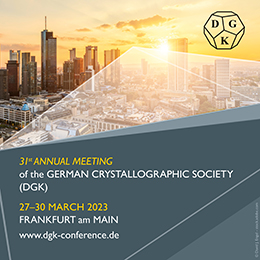


Feature article
Star polyhedra
![thumbnail [thumbnail]](https://www.iucr.org/__data/assets/image/0009/155466/thumbnail.jpg)
Detail of the interior of the shopping mall at One Columbus Circle, Manhattan (photograph by the author).
Let’s start with some definitions [1]. There are five regular polyhedra: the tetrahedron, cube (hexahedron), octahedron, dodecahedron and icosahedron. They are also called Platonic solids because they were an important component of Plato’s natural philosophy. The faces of the regular polyhedra are regular polygons: regular triangles, regular pentagons or squares. A regular polyhedron has regular and equal faces, and their vertices are surrounded alike. When we speak about the five regular polyhedra, a qualifier should be added: they are convex regular polyhedra. A polyhedron is convex if every dihedral angle is smaller than 180°. The dihedral angle is the angle formed by two polygons joined along a common edge. If the convex restriction is lifted, the number of regular polyhedra rises from five to nine. The additional ones are the four regular star polyhedra, depicted here after Cundy & Rollett [2].
![[1Hargittai]](https://www.iucr.org/__data/assets/image/0010/155467/1-Hargittai.jpg)
My interest in the star polyhedra dates back to an accidental “discovery” in the early 1990s. At that time, it was still possible to climb out onto some small balconies at the top of St Peter’s Basilica, Vatican City (such adventures have been blocked since because of safety precautions — I learned about this during a subsequent visit). A captivating view appeared from one of those small balconies: it was a bird’s eye view of the Sacristy of the Basilica. At a closer look, a beautiful star polyhedron could be seen, just beneath the cross. This experience initiated some studies and inquiries [3].
The Sacristy was built by the architect Carlo Marchionni in the years 1776–1784. The beautiful star polyhedron at its top is a great stellated dodecahedron, also called Kepler’s great stellated dodecahedron. However, it is not perfect, as two of its 20 triangular pyramids are missing in order to accommodate the vertical stand of the cross above the polyhedron.
![[23Hargittai]](https://www.iucr.org/__data/assets/image/0007/155752/23.jpg)
On a subsequent visit, I contacted some Vatican officials to inquire about the significance of the star polyhedron at the top of the Sacristy, but nobody seemed to know about its origin or significance. As I visited the interior of the Sacristy, I noticed several small ornate stands on the altar, holding similar star polyhedra.
Once I had noticed the top decoration of the Sacristy, I started noticing star polyhedra elsewhere, and they appeared to be quite common with frequent decorations at the tops of church towers and other prominent places [3]. Often, the star polyhedra decorating public places are not exactly regular, but slight deviations do not disturb the viewing pleasure. There is a gradual transition between genuine star polyhedra and just a bunch of spikes radiating from the center. An example of a not quite regular star polyhedron is presented here from the Petrovsky Palace in Moscow [4].
![[45combinedHargittai]](https://www.iucr.org/__data/assets/image/0007/155473/45combinedHargittai.jpg)
The Petrovsky Palace was designed by Matvei F. Kazakov and built in the years 1776–1782, so it was a contemporary of the Sacristy in Vatican City. The Palace was built by the order of Catherine II, also known as Catherine the Great. Its purpose was to serve as a resting place for the Tsar or Tsarina when traveling from St Petersburg to Moscow. At the time, it was well outside Moscow, at a considerable distance from the destination of the sovereign’s trip; today it is well within the Moscow city limits. Travelers arrived at the Moscow Kremlin fresh and rested after this stopover. In the Soviet era, the Palace housed the Zhukovsky Air Force Academy. The kosmonauts (the Russian word for astronauts) Yury Gagarin and Valentina Tereshkova and the airplane designers Sergei Ilyushin and Aleksandr Yakovlev studied here, amongst many others. Eventually, the Air Force Academy moved out, the Palace was renovated, and it has served close to its original purpose: functioning as a hotel for traveling dignitaries [5].
The star polyhedra of the Petrovsky Palace do not correspond to any of the regular star polyhedra, but correspond to one of the 59 stellated icosahedra [The 59 Icosahedra – once opened, this site presents a rotating model (animation) of the stellated icosahedron No. 18], as suggested by Nikolai Dolbilin of the Moscow Steklov Institute of Mathematics [6]. On Magnus Wenninger’s so-called Wenninger’s List, this polyhedron stands under No. 34 (https://en.wikipedia.org/wiki/Great_triambic_icosahedron).
I conclude this note with a challenge to the reader to find the closest identification among star polyhedra for the decoration depicted above from the building at One Columbus Circle, Manhattan, New York; at the time it was the Time-Warner Building.
References
[1] Hargittai, M. & Hargittai, I. (2009). Symmetry through the Eyes of a Chemist, 3rd ed., pp. 76–90. Springer.[2] Cundy, H. M. & Rollett, A. P. (1961). Mathematical Models. Oxford: Clarendon Press.
[3] Hargittai, I. (1996). Math. Intell. 18, 52–54.
[6] Dolbilin, N. (2021). Private communication.
Istvan Hargittai is at Budapest University of Technology and Economics, Hungary.
Copyright © - All Rights Reserved - International Union of Crystallography









